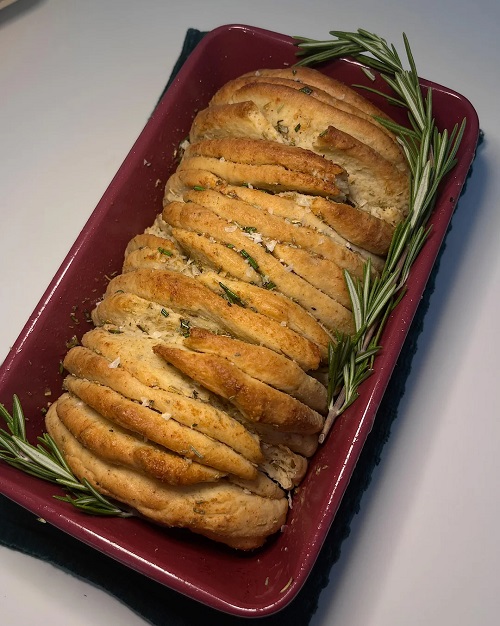Make this soft and buttery Rosemary Garlic Pull-Apart Bread at home. It’s fluffy, cheesy, and full of rich garlic-herb flavor.
Rosemary Garlic Pull-Apart Bread is soft, buttery, and full of flavor. Each piece is layered with garlic, herbs, and cheese, making it perfect for sharing. It’s easy to make at home and bakes into a golden, pull-apart loaf that’s warm, fragrant, and delicious with any meal.
Rosemary Garlic Pull-Apart Bread
Ingredients
Dough
2 teaspoons Platinum Yeast
1 large egg
2 and 1/3 cups (291g) all-purpose flour (spooned & leveled), plus more as needed*
3/4 cup (180ml) whole milk
1 Tablespoon finely chopped fresh rosemary (or 2 teaspoons dried)
1 teaspoon salt
1 teaspoon garlic powder
3 Tablespoons (43g) unsalted butter, softened to room temperature
1 Tablespoon granulated sugar
Filling
5 Tablespoons (71g) unsalted butter, extra soft (see note)
1/4 teaspoon salt
3/4 cup (95g) shredded parmesan, mozzarella, or white cheddar cheese (or your favorite shredded cheese)
1 Tablespoon finely chopped fresh parsley (or 2 teaspoons dried)
2 garlic cloves, minced or 1/2 teaspoon garlic powder
1 Tablespoon finely chopped fresh rosemary (or 2 teaspoons dried)
Direction
- Put the yeast and sugar in a large mixing bowl or the bowl of a stand mixer with a dough hook or paddle attachment. Warm the milk on the stove or in the microwave until it’s about 110°F (43°C) — warm to the touch but not hot. Pour the warm milk over the yeast and sugar. Stir gently, cover the bowl loosely with a clean towel, and let it sit for 5–10 minutes until the mixture becomes frothy.
- Next, add the butter, egg, flour, salt, garlic powder, and rosemary. Mix on low speed (or use a wooden spoon or silicone spatula if mixing by hand) until the dough comes together and starts pulling away from the sides of the bowl — this takes about 3 minutes. If it doesn’t pull away, add a bit more flour, one tablespoon at a time. The dough should be soft.
- Keep the dough in the mixer and switch to the dough hook (if you were using the paddle), then beat for another 5 minutes. If you’re kneading by hand, place the dough on a lightly floured surface and knead for 5 minutes. If the dough feels too sticky, add a little flour—about 1 tablespoon at a time—until it becomes soft and slightly tacky. Don’t add too much flour, or the dough will turn dry.
- When you’re done kneading, the dough should feel soft and springy. Press it gently with your finger—if it slowly bounces back, it’s ready to rise. You can also check with the “windowpane test”: take a small piece of dough (about the size of a golf ball) and stretch it gently. If you can see light through it without it tearing, the dough is ready. If it tears, knead a little longer and test again.
- Shape the dough into a smooth ball. Put it in a greased bowl (you can use nonstick spray for this). Cover the bowl with plastic wrap or aluminum foil. Place it in a warm spot and let it rise until it doubles in size, which usually takes about 60 to 90 minutes.
- While the dough is rising, make the filling and grease a 9×5-inch loaf pan.
- To make the filling, mix the soft butter, rosemary, parsley, garlic, and salt in a medium bowl. If the butter is soft, you can stir everything together with a spoon or fork. You can also use an electric mixer if you prefer. Cover the bowl tightly and set it aside until you’re ready to use it. Don’t put it in the fridge unless you’re making it ahead of time. The filling spreads best when it’s at room temperature. If it’s been in the fridge, let it soften before using.
- Gently punch down the dough to release the air. Place it on a lightly floured surface. Divide the dough into 12 equal pieces, each about the size of a golf ball (around 1/4 cup of dough). With floured hands, press each piece into a circle about 4 inches wide. It doesn’t need to be perfectly round. You can use a rolling pin if you like, but it’s not necessary.
- Spread 1–2 teaspoons of the filling on each circle, then sprinkle about 1 tablespoon of cheese on top. Fold each circle in half and place them in the greased loaf pan, round side facing up.
- Cover the loaf with plastic wrap or aluminum foil and let it rise again in a warm place until it looks puffy, about 45 minutes.
- Move your oven rack to the lower third position and preheat the oven to 350°F (177°C). Bake the bread for about 50 minutes, until it turns golden brown. If the top starts to brown too quickly, cover it loosely with aluminum foil. Don’t worry if you see melted butter around the edges—it will soak into the bread as it finishes baking.
- Remove the bread from the oven and place the pan on a wire rack to cool. If you like, brush the top with melted butter and sprinkle some sea salt for extra flavor.
- Let the bread cool in the pan for 10 minutes, then take it out and serve it warm.
- Cover and store any leftovers at room temperature for up to 2 days or in the fridge for up to 1 week. The crust may get a little hard after the first day since it’s crispy. To make it soft again, reheat it in a 300°F (149°C) oven for 10–15 minutes or warm it in the microwave.




